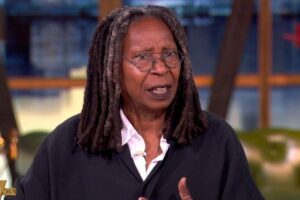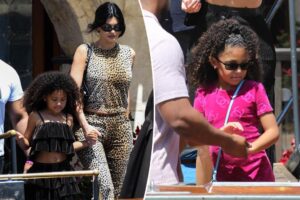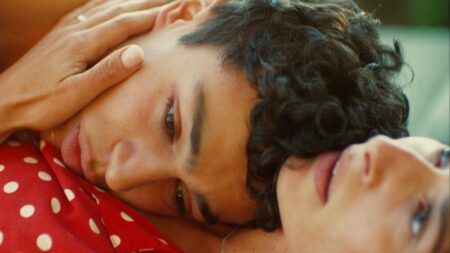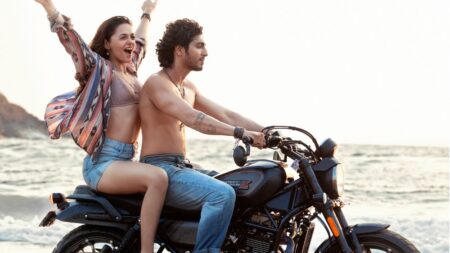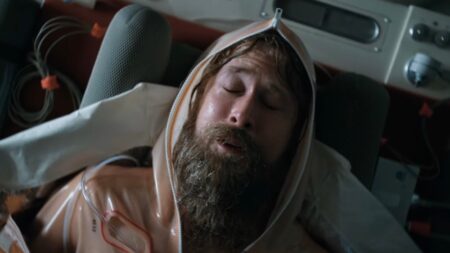When Richard Linklater set off to direct “Nouvelle Vague,” a black-and-white tribute to Jean-Luc Godard that charts the making of his debut film “Breathless,” the Oscar-nominated American director spared no details. He recreated the 1959 classic’s Parisian setting, lighthearted mood and three-way chemistry between the two leads and their director – played by Jean Seberg, Jean-Paul Belmondo and Godard lookalikes: Zoey Deutch, Aubry Dullin and Guillaume Marbeck.
While speaking about the film at Biarritz’s Nouvelle Vague Festival where his latest film played on opening night this week, Linklater and “Nouvelle Vague” producer Michele Halberstadt said that everything seen in the film — which had a rapturous world premiere in competition at Cannes — happened in real life. New Wave film buff Linklater did extensive research alongside Halberstadt, who knew Godard well throughout her career in journalism. Halberstadt one point headed Premiere magazine in France before launching her production and distribution company ARP Selection with her husband Laurent Petin.
Linklater’s movie depicts the young Godard as a film critic at Les Cahiers du Cinema; his feisty relationship with his producer Georges de Beauregard who grew frustrated with the young director’s eccentric methods and almost pulled the plug and his sincere friendship with other New Wave filmmakers, such as Francois Truffaut and Jacques Rivette, as well as Jean-Pierre Melville who did a cameo in “Breathless.” Also shown is his ambivalent rapport with Seberg, whom he challenged and refused to treat as the Hollywood star she was, and his ease directing the happy-go-lucky Belmondo.
“I love the Nouvelle Vague, and Godard was so unusual,” Linklater said on stage in Biarritz. “This film gives us an opportunity to go back and think of the cinema as in a time capsule. We all get in it and we go back to 1959, and we hang out with not just Godard, but the entire Nouvelle Vague, the Cahiers de Cinema, and we’re just hanging out with them as Jean-Luc tries to make his first film,” Linklater continued.
Linklater is far from a beginner, having already earned a handful of Oscar nominations with “Boyhood” and his Julie Delpy-Ethan Hawke movies “Before Sunset” and “Before Midnight.” He’d never directed a full movie in a foreign language which he doesn’t speak, but “Nouvelle Vague” indeed shot in French, with only a few lines of dialogue in English.
He admitted he had a “system in place” during filming and was “completely reliant” on Halberstadt (who worked on adapting the script to French with Laetitia Masson) and his crew which made the production of “Nouvelle Vague” a collective experience.
“I was just looking at the actors’ behavior and how comfortable they were, but on set, I was worried so we had a system with Michele, and primarily the script supervisor, and then ultimately, the editor,” he said. “I would look at it and I go, ‘Did they mess up that?’”
He also sounded the cast out. “I really needed confirmation from the actors themselves. I’d ask, ‘Was that good?” Possibly more than on a traditional movie set, Linklater said he “put a lot of trust in people (he) was working with.”
Although he started out with an English script, he had no hesitation about making “Nouvelle Vague” in French.
“We had an English script and a French script, and then immediately we went to the French one, because in my mind, I was making an English subtitled movie,” said Linklater. “Because that’s what the Nouvelle Vague is to me, it’s is the beautiful language. The sound of cinema to me is French language, but with English subtitles. I love the subtitled version.”
Linklater was also eager to avoid technical anachronisms in “Nouvelle Vague,” and that came with a number of restrictions. “It was fascinating on this film to get inside another film and another filmmaking era due to the budgets and what their films looked like and the techniques they used,” Linklater said. “It’s very simple, actually. I had to erase cinema history after the early ’60s and not think of crane shots, no Steadicam, no dolly camera.”
“You had to shoot it the way they shot. It was fun to have a restrictive palette and keep it a bit simple the way they did,” Linklater continued.
Linklater’s “Nouvelle Vague” shows how Godard worked without a proper script and guided his cast with fragments of scenes and poems or songs, and often did a single take for each scene to seize the most spontaneous performances. But as shown by Lucie Saada in her short film “Le Making of de Nouvelle Vague,” a behind-the-scenes look at the production which also played at the Biarritz Festival, Linklater had a much more meticulous and relentless approach. In the short, Deutch, Marbeck and Linklater are seen doing take after take to capture the essence and tone of each scene of “Breathless” and interactions off-sets.
Linklater also worked with many newcomers on “Nouvelle Vague,” starting with Marbeck and Dullin, who had never acted in a feature film.
“Richard has helped us a lot,” said Marbeck. “He gave us a manifesto, and he told us, ‘You don’t play Jean-Luc Godard, Jean-Paul Belmondo and Jean Seberg. You’re playing Jean-Luc, Jean-Paul, Jean, and these are only young people who have a lot of hope in cinema, a lot of hope in what they can do, what they can bring to the world,’” Marbeck said. The manifesto must have struck a chord because Marbeck, who had only starred in a couple of shorts before, pulls off an impressive performance as Godard, down to his unique way of speaking and mannerism. As Variety‘s Owen Gleiberman points out, Deutch is a “force” as Seberg.
Acquired by Netflix at the Cannes Film Festival, “Nouvelle Vague” now has a shot at scoring France’s first Oscar for best international feature in over three decades — if the French Oscar committee chooses it as its official candidate.
Read the full article here
